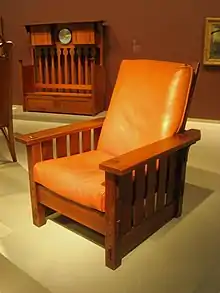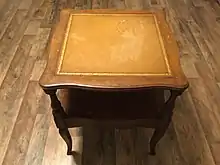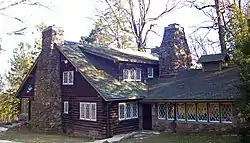Gustav Stickley
Gustav Stickley (March 9, 1858 – April 15, 1942) was an American furniture manufacturer, design leader, publisher, and a leading voice in the American Arts and Crafts movement. Stickley's design philosophy was a major influence on American Craftsman architecture.
Gustav Stickley | |
|---|---|
 | |
| Born | March 9, 1858 |
| Died | April 21, 1942 (aged 84) |
| Nationality | American |
| Known for | Furniture design |
| Notable work | Craftsman furniture |
| Movement | Arts and Crafts movement |
| Spouse | Eda Ann Simmons |
Early life
One of eleven children of German émigrés Leopold and Barbara Schlager Stoeckel, Gustav Stickley was born Gustavus Stoeckel on March 9, 1858, in Osceola, Wisconsin. The eldest surviving son, Stickley experienced the rigors of life growing up on a small Midwestern farm, forgoing his formal education in 1870 to continue work in his father’s field of stonemasonry and help support his struggling family. By early 1876, Stickley’s mother and siblings moved to Brandt, Pennsylvania, where Gustav worked in his uncle’s chair factory – his first formal training in the furniture industry.
Early career
With his brothers Charles and Albert, Gustav formed Stickley Brothers & Company in 1883, the same year he married Eda Ann Simmons.[1] Within five years, the company was dissolved and Stickley’s ambitions led him to partner with Elgin Simonds, a salesman in the furniture trade, to form the firm Stickley & Simonds in Binghamton, New York. During the 1890s, Stickley divided his efforts between his new enterprise and the Auburn State Prison. At the prison, he and his brother Leopold served as a foremen of furniture operations. In 1898, he orchestrated the removal of his business partner and formed the Gustave Stickley Company (he dropped the use of the "e" from his first name in 1903).
In the summer of 1900, he worked with Henry Wilkinson and, possibly, LaMont A. Warner (soon his first staff designer) to create his first Arts and Crafts works in an experimental line called the New Furniture. In 1901, he changed the name of his firm to the United Crafts, issued a new catalogue written by Syracuse University professor Irene Sargent, and began to offer middle class consumers a host of progressive furniture designs in ammonia-fumed quartersawn white oak, as well as chestnut, mahogany, maple and other woods.
The Craftsman
In October 1901, Stickley published the first issue of The Craftsman magazine, an important vehicle for promoting Arts and Crafts philosophy as well as the products of his factory within the context of articles, reviews, and advertisements for a range of products of interest to the homemaker. Lead articles in the first two issues paid tribute to two influencers of Stickley and Sargent's design philosophies: William Morris and John Ruskin.
Nearly all of the first three issues of The Craftsman were written by Sargent, who thereafter wrote each issue's lead article, acted as the managing editor and designed the magazine's layouts.[2] The magazine also featured articles by libertarian socialists.[3]
Furniture design

Stickley's new furniture reflected his ideals of simplicity, honesty in construction, and truth to materials. Unadorned, plain surfaces were enlivened by the careful application of colorants so as not to obscure the grain of the wood and mortise and tenon joinery was exposed to emphasize the structural qualities of the works. Hammered metal hardware, in armor-bright polished iron or patinated copper emphasized the handmade qualities of furniture which was fabricated using both handworking techniques and modern woodworking machinery within Stickley's Eastwood, New York, factory (now a part of Syracuse, New York). Dyed leather, canvas, terry cloth and other upholstery materials complemented the designs.
Those ideals – simplicity, honesty, truth – were reflected in his trademark, which includes the Flemish phrase Als Ik Kan inside a joiner's compass. The phrase is generally translated 'to the best of my ability.'
His firm's work, both nostalgic in its evocation of handicraft and the pre-industrial era and proto-modern in its functional simplicity, was popularly referred to as being in the Mission style, though Stickley despised the term as misleading. In 1903, he changed the name of his company again, to the Craftsman Workshops, and began a concerted effort to market his works – by then including furniture as well as textiles, lighting, and metalwork – as Craftsman products. Ultimately, over 100 retailers across the United States represented the Craftsman Workshops.
In 1902, the later world-renowned sculptor Jerome Connor was hired to head up Stickley's metal work department.[4] Architect E. G. W. Dietrich contributed his design and accompanying essay titled “The Cottage Quality” to the February and April 1903 editions of The Craftsman magazine.[5][6] Then in May 1903, the magazine published the first “Craftsman House” designed by Dietrich in cooperation with Stickley. The article featured a house design and drawings by Dietrich including an exterior view, floor plans, and detailed interior views showcasing Stickley furniture.[7] In May 1903, Stickley hired Rochester architect Harvey Ellis. Although Ellis died only a few months later, in January 1904, he had an immediate and profound effect upon design of The Craftsman magazine, its architectural offerings, and the furnishings Stickley was producing, reinforcing the connections between Stickley's work and that of English and Glaswegian designers. During this year Stickley's furniture evolved from solid, monumental forms to lighter shapes, relieved by arches, tapering legs, and – in a new experimental line – inlay as decoration. Within a year the inlay designs would be all but dropped from production save special orders, but the broader emphasis on less massive forms would remain. In keeping with this new emphasis, Stickley also began offering furniture in willow to complement the heavier oak designs. Furthering the development of his concept of the Craftsman home, in late 1903 he announced the formation of the Craftsman Home Builders Club to provide architectural plans from The Craftsman to its subscribers. The homes were offered in a number of archetypes familiar to American public – the farmhouse, town house, cottage, and bungalow, among others. Natural materials and soft colors predominated and interiors were invariably prescribed to include simplified moldings, stained wood, and characteristic features such as built-in cabinets and fireplaces with inglenooks for seating. Although these homes were only rarely innovative in terms of progressive style, designs reflected current approaches to open floor plans, economy of function, and use of novel materials for walls, roofs, and surface treatments.
Craftsman Farms
Stickley moved his headquarters to New York City in 1905 and by 1907 began to acquire property to establish a boarding school for boys in Morris Plains, New Jersey (what is now Parsippany, New Jersey). Craftsman Farms was designed to include vegetable gardens, orchards, dairy cows and chickens.[8] The main house there is constructed from chestnut logs and stone found on the property. As he wrote in The Craftsman:
There are elements of intrinsic beauty in the simplification of a house built on the log cabin idea. First, there is the bare beauty of the logs themselves with their long lines and firm curves. Then there is the open charm felt of the structural features which are not hidden under plaster and ornament, but are clearly revealed, a charm felt in Japanese architecture. ... The quiet rhythmic monotone of the wall of logs fills one with the rustic peace of a secluded nook in the woods.[9]
Although the main house at Craftsman Farms was initially conceived of as a clubhouse for students, lack of interest in the school prompted Stickley to live there with his family instead. The planned school never became a reality. By 1913, changing tastes and the financial strain of his new twelve-story Craftsman Building in Manhattan, conceived as a department store, began to take their toll; in 1915 he filed for bankruptcy, stopping publication of The Craftsman in December 1916 and selling Craftsman Farms in 1917.
Legacy
Gustav Stickley died on April 21, 1942.[10] He is buried in the Oakwood Cemetery in Syracuse, New York.
In recent decades, Stickley and his work have become popularly recognized once again. It is particularly his early furniture, produced between 1900 and 1904, that is often seen as appealing to collectors. In 1988, Barbra Streisand paid $363,000 for a Stickley sideboard from the Gustav Stickley House in Syracuse.[11] An article written by the Associated Press stated that “Streisand’s telephone bid on the 1903 sideboard set a record for a Stickley piece and for a single piece of American Arts and Crafts movement furniture.”[12] During an auction in 1999, Streisand sold that same sideboard for $540,000 to a then-unnamed buyer; the sideboard subsequently appeared within the collection of the Two Red Roses Foundation. An article written by CBS News stated that “the winning bid set a (auction) record for a piece of furniture from the Arts and Crafts movement.”[13] Magazines such as Style 1900[14] (out of print as of January 2013) and American Bungalow[15] cater to those interested in the Arts and Crafts movement. A major touring exhibition organized by the Dallas Museum of Art, Gustav Stickley and the American Arts & Crafts Movement, opened at the Newark Museum on September 15, 2010. The exhibition then opened at the Dallas Museum of Art on February 18, 2011, and remained on view until May 8, 2011, before opening at the San Diego Museum of Art on June 18, 2011, subsequently closing on September 11, 2011.[16]

Gustav's brothers Leopold Stickley (Lee), Albert Stickley, Charles Stickley and John George Stickley also produced Arts and Crafts furniture. (Albert Stickley and John George Stickley founded the Stickley Brothers Furniture Company of Grand Rapids in 1891. The Grand Rapids company ceased production in the 1950s.[17][18]) Although no longer held by the Stickley family, the successor firm to the L. & J.G. Stickley Company continues to operate in Manlius, New York, producing a variety of styles, including many original Gustav Stickley Arts and Crafts designs. The Company operates a museum, located in the original L & J. G. factory building. It features the work of the Stickley brothers and is located near its current factory site.[19]
See also
- Arts and Crafts movement
- Craftsman Farms, Parsippany, New Jersey
- Gustav Stickley House, Syracuse, New York
References
- Renn, Melissa. "Gustav Stickley." In Immigrant Entrepreneurship: German-American Business Biographies, 1720 to the Present, vol. 3, edited by Giles R. Hoyt. German Historical Institute. Last modified May 13, 2016.
- Zipf, Catherine W. Professional Pursuits: Women and the American Arts and Crafts Movement. Knoxville: University of Tennessee Press, 2007, pp. 143–48.
- Antliff, Allan (2001). Anarchist Modernism: Art, Politics, and the First American Avant-Garde. Chicago: University of Chicago Press. p. 22. ISBN 9780226021034. Retrieved August 4, 2014.
gustav stickley.
- "Early Artisans: Jerome Connor- Elbert Hubbard: An American Original | PBS". PBS. Archived from the original on 2009-12-04.
- Dietrich, E. G. W. (February 1903). "The Cottage Quality". The Craftsman. 3: 280–282 – via Haithi Trust.
- Dietrich, E. G. W. (April 1903). "An Interior". The Craftsman. 4: 56–57 – via Haithi Trust.
- "The Craftsman House". The Craftsman. 4: 82–92. May 1903 – via Haithi Trust.
- Mark Alan Hewitt, Gustav Stickley's Craftsman Farms: The Quest for an Arts and Crafts Utopia, Syracuse Univ. Press, 2001, Chapter 3.
- "Craftsman Farms". Stickley Museum. Archived from the original on 2009-04-29. Retrieved 2009-06-03.
- "G. Stickley Dies. Furniture Maker". New York Times. April 22, 1942. Retrieved 2008-07-03.
Designed 'Modern' Pieces 50 Years Ago and Was Founder of a National Magazine. Had First Trolley Line. Operated One at Binghamton, N.Y. Held to Handicraft Ideals in Factory Output. Mr. Stickley also was founder, publisher and editor of The Craftsman, ... The name was Americanized to Stickley. At the age of 12 Mr. Stickley learned the ...
- Klages, Karen (June 12, 1994). "ARTS AND CRAFTS REVIVAL". Chicago Tribune. Retrieved 26 November 2022.
- "Streisand Pays $363,000 For Furniture By Craftsman Gustav Stickley". Associated Press . December 10, 1988. Retrieved 24 November 2022.
- "Streisand Auction Fetches $3M". CBS News. November 30, 1999. Retrieved 25 November 2022.
- Style 1900 Archived 2004-12-14 at the Wayback Machine
- American Bungalow
- "First Nationally Touring Exhibition of the Work of Gustav Stickley, Patriarch of the American Arts and Crafts Movement, Organized by Dallas Museum of Art | Dallas Museum of Art".
- "How to Identify Stickley Brothers Furniture". SFGATE. Retrieved 24 November 2022.
- "Stickley Brothers Furniture Co". Grand Rapids Historical Commission. Retrieved 24 November 2022.
- Stickley Museum website
Further reading
- Cathers, David M. (1981). Furniture of the American Arts and Crafts Movement. The New American Library, Inc. ISBN 0-453-00397-4.
- Cathers, David M. (2003). Gustav Stickley. Phaidon Press. ISBN 0-7148-4030-0.
- Hewitt, Mark Alan. (2001). Gustav Stickley's Craftsman Farms: The Quest for an Arts and Crafts Utopia. Syracuse University Press. ISBN 0-8156-0689-3.
- Smith, Mary Ann. (1992). Gustav Stickley: The Craftsman. Dover Publications. ISBN 0-486-27210-9.
- Stubblebine, Ray. (2006). Gustav Stickley's Craftsman Homes: Plans, Drawing, Photographs. Gibbs Smith. ISBN 1-58685-379-1.
- Tucker, Kevin W. (2010). Gustav Stickley and the American Arts & Crafts Movement. Yale University Press. ISBN 978-0-300-11802-5
External links
- "Gustav Stickley and the Craftsman Home"
- Stickley shop marks and related historical furniture maker details
- The Stickley Museum at Craftsman Farms
- Findagrave: Gustav Stickley
- Craftsman Style
- Gustav Stickley and the Morris chair
- The Craftsman (1901-1916).: Presented here is a full-text digital facsimile of The Craftsman (1901-1916). The monthly journal was dedicated to the products, ideals and philosophy of the Arts and Crafts movement. The Craftsman espoused the ideal of simple, functional design and the "necessity of producing good art as a means to improve public morals and further public happiness" (Foreword from v.2, no.3, 1902).
- Craftsman homes. Stickley, Gustav, 1858-1942. New York, New York: Craftsman Publishing Company, 1909.
- The Winterthur Library- Overview of the collection on Gustav Stickley.
- Craftsman Homes Updates to the book Stickley's Craftsman Homes: Plans, Drawings, Photographs and further information related to Gustav Stickley and his Craftsman Homes
- Complete list of Furniture Items from the 1910 Gustav Stickley catalog.
- Craftsman Architects drawings, 1904-1915, held by the Avery Architectural and Fine Arts Library, Columbia University
